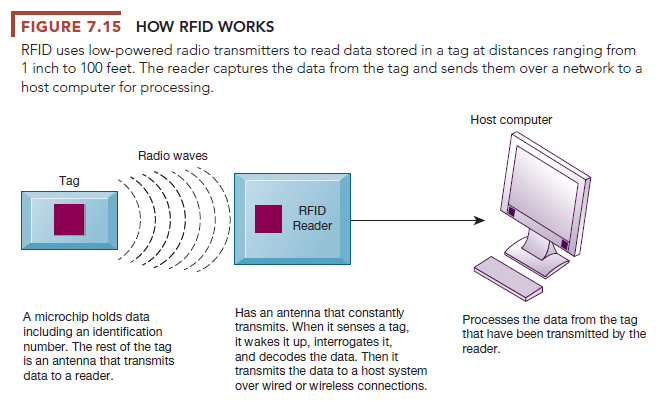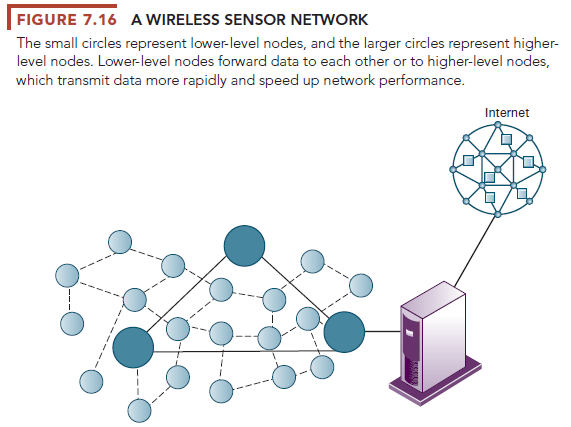Mobile technologies are creating new efficiencies and ways of working throughout the enterprise. In addition to the wireless systems we have just described, radio frequency identification systems and wireless sensor networks are having a major impact.
1. Radio Frequency Identification (RFID) and Near Field Communication (NFC)
Radio frequency identification (RFID) systems provide a powerful technology for tracking the movement of goods throughout the supply chain. RFID systems use tiny tags with embedded microchips containing data about an item and its location to transmit radio signals over a short distance to RFID readers. The RFID readers then pass the data over a network to a computer for processing. Unlike bar codes, RFID tags do not need line-of-sight contact to be read.
The RFID tag is electronically programmed with information that can uniquely identify an item plus other information about the item such as its location, where and when it was made, or its status during production. The reader emits radio waves in ranges anywhere from 1 inch to 100 feet. When an RFID tag comes within the range of the reader, the tag is activated and starts sending data.

The reader captures these data, decodes them, and sends them back over a wired or wireless network to a host computer for further processing (see Figure 7.15). Both RFID tags and antennas come in a variety of shapes and sizes.
In inventory control and supply chain management, RFID systems capture and manage more detailed information about items in warehouses or in production than bar coding systems. If a large number of items are shipped together, RFID systems track each pallet, lot, or even unit item in the shipment. This technology may help companies such as Walmart improve receiving and storage operations by improving their ability to see exactly what stock is stored in warehouses or on retail store shelves. Macy’s uses RFID technology to track individual items for sale on store shelves.
Walmart has installed RFID readers at store receiving docks to record the arrival of pallets and cases of goods shipped with RFID tags. The RFID reader reads the tags a second time just as the cases are brought onto the sales floor from backroom storage areas. Software combines sales data from Walmart’s point-of-sale systems and the RFID data regarding the number of cases brought out to the sales floor. The program determines which items will soon be depleted and automatically generates a list of items to pick in the warehouse to replenish store shelves before they run out. This information helps Walmart reduce out-of-stock items, increase sales, and further shrink its costs.
The cost of RFID tags used to be too high for widespread use, but now it starts at around 7 cents per tag in the United States. As the price decreases, RFID is starting to become cost-effective for many applications.
In addition to installing RFID readers and tagging systems, companies may need to upgrade their hardware and software to process the massive amounts of data produced by RFID systems—transactions that could add up to tens or hundreds of terabytes.
Software is used to filter, aggregate, and prevent RFID data from overloading business networks and system applications. Applications often need to be redesigned to accept large volumes of frequently generated RFID data and to share those data with other applications. Major enterprise software vendors now offer RFID-ready versions of their supply chain management applications.
Tap-and-go services like Apple Pay or Google Wallet use an RFID-related technology called near field communication (NFC). NFC is a short-range wireless connectivity standard that uses electromagnetic radio fields to enable two compatible devices to exchange data when brought within a few centimeters of each other. A smartphone or other NFC-compatible device sends out radio frequency signals that interact with an NFC tag found in compatible card readers or smart posters. The signals create a current that flows through the NFC tag, allowing the device and the tag to communicate with one another. In most cases the tag is passive and only sends out information while the other device (such as a smartphone) is active and can both send and receive information. (There are NFC systems where both components are active.)
NFC is used in wireless payment services, to retrieve information, and even to exchange videos or information with friends on the go. You could share a website link by passing your phone over a friend’s phone, while waving the phone in front of a poster or display containing an NFC tag could show information about what you’re viewing at a museum or exhibit.
2. Wireless Sensor Networks
If your company wanted state-of-the art technology to monitor building security or detect hazardous substances in the air, it might deploy a wireless sensor network. Wireless sensor networks (WSNs) are networks of interconnected wireless devices that are embedded in the physical environment to provide measurements of many points over large spaces. These devices have built- in processing, storage, and radio frequency sensors and antennas. They are linked into an interconnected network that routes the data they capture to a computer for analysis. These networks range from hundreds to thousands of nodes. Figure 7.16 illustrates one type of wireless sensor network, with data from individual nodes flowing across the network to a server with greater processing power. The server acts as a gateway to a network based on Internet technology.

Wireless sensor networks are valuable for uses such as monitoring environmental changes; monitoring traffic or military activity; protecting property; efficiently operating and managing machinery and vehicles; establishing security perimeters; monitoring supply chain management; or detecting chemical, biological, or radiological material.
Output from RFID systems and wireless networks is fueling the Internet of Things (IoT), introduced earlier in this chapter, in which machines such as jet engines, power plant turbines, or agricultural sensors constantly gather data and send the data over the Internet for analysis. The data might signal the need to take action such as replacing a part that’s close to wearing out, restocking a product on a store shelf, starting the watering system for a soybean field, or slowing down a turbine. Over time, more and more everyday physical objects will be connected to the Internet and will be able to identify themselves to other devices, creating networks that can sense and respond as data changes. The Tour de France race tracking system, described in the chapter-opening case, is an example of an IoT application.
Source: Laudon Kenneth C., Laudon Jane Price (2020), Management Information Systems: Managing the Digital Firm, Pearson; 16th edition.

This is very attention-grabbing, You are an excessively professional blogger.
I’ve joined your feed and stay up for seeking extra of your fantastic post.
Also, I have shared your website in my social networks
I¦ve recently started a site, the information you provide on this site has helped me greatly. Thanks for all of your time & work.